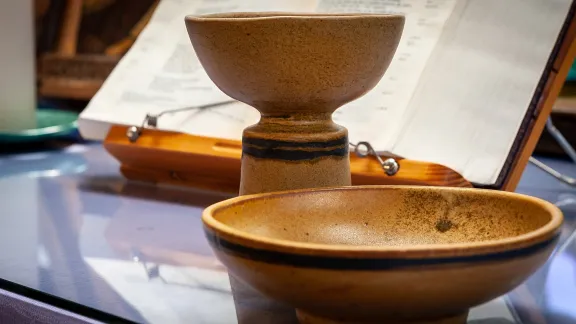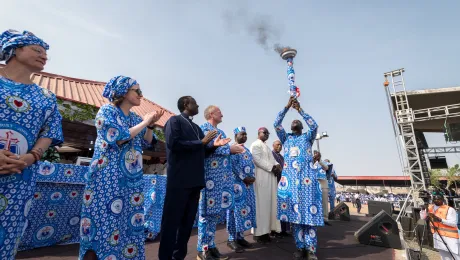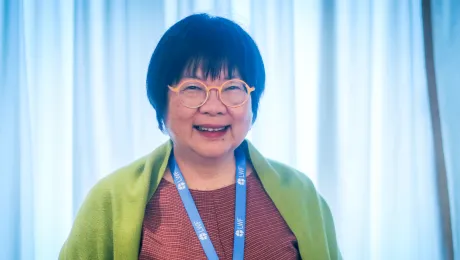
The communion sets are an expression of the LWF’s commitment to diaconal work, and the living faith, and meant to be used in services and festivities. Photo: LWF/ S. Gallay
Symbol of diaconal and ecumenical commitment
(LWI) - The Lutheran World Federation (LWF), with the support of the ecumenical Taizé community, has created a collection of pottery gifts that highlight the organization's core values. The pieces, crafted by Taizé's renowned pottery workshop, feature a unique glaze from sand collected in refugee camps where LWF works. This project reflects LWFs commitment to ecumenical relations, humanitarian service, and the practical application of faith, ensuring that each gift remains a living testament to its mission.
Dust from their feet
The gifts started with four bags of sand from the four refugee camps that make up Dadaab, the Kenyan refugee camp at the Somalian border. The LWF Country Representative in Kenya brought them to the Communion Office in Geneva to symbolize the realities and challenges in LWF's humanitarian and development work, carried out in 25 countries worldwide.
The LWF Country Program in Jordan followed the example, and sent sand from the Zaatari refugee camp, where LWF works with refugees from Syria. The idea arose to transform the sand into something meaningful. The ecumenical Taizé community agreed to test samples and develop a glaze. The pieces were made from local clay and then coated with the sand from the refugee camps.
“These gifts highlight three aspects of LWF's work," says General Secretary Rev. Dr Anne Burghardt. “An ecumenical partner, the Communauté de Taizé in France, has made them, highlighting LWF's commitment to ecumenical relations.” The Taizé community in Burgundy, France, is best known for its spiritual retreats that attract thousands of young people every year. However, Taizé is also home to a well-known pottery workshop.
The sand for the glazing comes from the Dadaab and Zaatari refugee camps where LWF works, highlighting the commitment to serving people in need. "It's like wrapping each piece with the story and resilience of the people in those camps," she adds. "It reminds us that LWF's work, the church's work, cannot be divided from service to the most vulnerable."
It's like wrapping each piece with the story and resilience of the people in those camps
Rev. Dr. Anne Burghardt, LWF General Secretary
The third aspect is using these gifts, especially the communion sets. "We leave these communion sets with our partners and member churches, not to be displayed on a shelf, but to be used in church services and festivities," the General Secretary says. "They remind us that faith is a living reality in life."
Beauty and function
The Taizé pottery workshop was founded in the 1950s by community members to support themselves and share their creativity. The pottery reflects simplicity, practicality, and a sense of spirituality. The workshop produces beautiful, functional ceramics like plates, bowls, cups, and liturgical objects such as chalices and candleholders. The designs are minimalist, often using earth tones and soft glazes, and focus on balancing utility and beauty.
The pottery connects with the Taizé community's commitment to manual labor and the values of simplicity and contemplation. Each piece is handcrafted, and the work is considered a form of prayer and meditation.
"This project is meaningful for us, as it allows us to create something both beautiful and functional from raw materials that carry a deeper significance," says Brother Bart, who headed the project in the Taizé community. "Several brothers contributed to the different stages of crafting these pieces, which also reflects our life in the community."
For the LWF, Taizé created cups, bowls, plates, a large serving plate, and a communion set.
LWF in Jordan and Kenya
The sand for the glaze comes from two LWF country programs: Kenya and Jordan.
The LWF World Service program in Kenya was founded in 1992, with the establishment of the Kakuma refugee camp In 2008, the United Nations High Commissioner for Refugees (UNHCR) requested LWF's support in Dadaab at the Somali border. In both camps, LWF is the leading implementation partner for education, meaning that it manages all primary and secondary schools. About 100,000 refugee children in those two camps learn in LWF-run schools. One of them is the Angelina Jolie boarding school for girls, founded by the UNHCR Special Envoy to cater for girls with special protection needs.
LWF Jordan was founded in 2012, responding to the refugee crisis following the Syrian civil war. The program focuses on vulnerable communities, refugees, and hosts alike. The "Peace Oasis" in Zaatari refugee camp is a psychosocial support center for children and young people. Many only know life in the refugee camp. LWF offers courses in music and arts, practical skills like computer training, and soccer teams. The Peace Oasis girls' football team has gained international recognition as a safe space for young girls to practice and build community.


